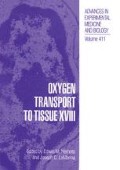Abstract
Turtle brain survives anoxia by maintaining ATP levels necessary to avoid the loss of ion homeostasis and the uncontrolled release of excitotoxic neurotransmitters [1–6]. A central question toward defining anoxic tolerance in turtle brain is how do ATP production and ATP use remain matched despite complete inhibition of oxidative metabolism. Indirect evidence of both a Pasteur effect and a hypometabolic state have been proposed previously. For example, calculations based on creatine phosphate depletion and lactate accumulation during anoxia suggested that ATP production was markedly reduced (by approx 88%) [1, 2]. Also, enzymatic studies of turtle brain suggested the presence of an initial Pasteur effect followed by a decrease in the glycolytic rate[7]. Depression of electrical activity in the turtle brain further strengthened the proposal of the presence of a hypometabolic state [5, 8–10].
Access this chapter
Tax calculation will be finalised at checkout
Purchases are for personal use only
Preview
Unable to display preview. Download preview PDF.
References
Chih, C.P., Z.C. Feng, M. Rosenthal, P.L. Lutz, and T.J. Sick, Energy metabolism, ion homeostasis, and evoked potentials in anoxic turtle brain. Am J Physiol, 257 (4 Pt 2): p. R854–R860. 1989.
Lutz, P.L., P. McMahon, M. Rosenthal, and T.J. Sick, Relationships between aerobic and anaerobic energy production in turtle brain in situ. Am J Physiol, 247 (4 Pt 2): p. R740–R744. 1984.
Lutz, P., G. Nilsson, and M. Perez-Pinzon, Anoxia tolerant animals, from a neurobiological perspective. Comp. Biochem. Physiol.,: p. In press. 1995.
Nilsson, G.E. and P.L. Lutz, Release of inhibitory neurotransmitters in response to anoxia in turtle brain. Am J Physiol, 261 (1 Pt 2): p. R32–R37. 1991.
Perez-Pinzon, M.A., M. Rosenthal, P.L. Lutz, and T.J. Sick, Anoxic survival of the isolated cerebellum of the turtle Pseudemis scripta elegans. J Comp Physiol [b], 162(1): p. 68–73. 1992.
Sick, T.J., M. Rosenthal, J.C. LaManna, and P.L. Lutz, Brain potassium ion homeostasis, anoxia, and metabolic inhibition in turtles and rats. Am J Physiol, 243(3): p. R281–R288. 1982.
Kelly, D.A. and K.B. Storey, Organ-specific control of glycolysis in anoxic turtles. Am J Physiol, 255 (5 Pt 2): p. R774–R779. 1988.
Feng, Z.C., M. Rosenthal, and T.J. Sick, Suppression of evoked potentials with continued ion transport during anoxia in turtle brain. Am J Physiol, 255(3 Pt 2): p. R478–R484. 1988.
Perez-Pinzon, M.A., M. Rosenthal, T.J. Sick, RL. Lutz, J. Pablo, and D. Mash, Downregulation of sodium channels during anoxia: a putative survival strategy of turtle brain. Am J Physiol, 262 (4 Pt 2): p. R712–R715. 1992.
Perez-Pinzon, M.A., C.Y. Chan, M. Rosenthal, and T.J. Sick, Membrane and synaptic activity during anoxia in the isolated turtle cerebellum. Am J Physiol, 263 (5 Pt 2): p. R1057–R1063. 1992.
Perez-Pinzon, M., J. Bedford, M. Rosenthal, P. Lutz, and T. Sick. Metabolic adaptations to anoxia in the isolated turtle cerebellum, in Soc. for Neuroscience. 1991.
Gnaiger, E., Heat dissipation and energetic efficiency in animal anoxibiosis: Economy contra power. J. Exp. Zooi, 228: p. 471–490.1983.
Larrabee, M.G., Oxygen consumption of excised sympathetic ganglia at rest and in activity. J. Neurochem., 2(81–101). 1958.
Martin, F.R., J. Sanchez-Ramos, and M. Rosenthal, Selective and nonselective effects of l-methyl-4-phenylpyridinium on oxygen consumption in rat striatal and hippocampal slices. J Neurochem, 57(4): p. 1340–1346. 1991.
Lowry, O.H. and J. Passonneau, A flexible system of enzyme analysis. 1972, New York: Academic Press.
Jackson, D.C., Metabolic depression and oxygen depletion in the diving turtle. J. Applied Physiol., 24: p. 503–509. 1968.
Lipton, P. and T. Wittingham, Energy metabolism and brain slice function, in Brain Slices, R. Dingledine, Editor. 1984, Plenum Press: New York and London, p. 113–153.
Mcllwain, H. and H. Bachelard, Biochemistry and the Central Nervous System. 1971, Edinburgh: Churchill Livingston.
Robin, E.D., N. Lewiston, A. Newman, L. Simon, and J. Theodore, Bioenergetic pattern of turtle brain and resistance to profound loss of mitochondrial ATP generation. Proc. Natl. Acad. Sci., 76: p. 3922–3926. 1979.
Wu, T. and E. Davies, Regulation of glycolytic flux in energetically controlled free system. Arch. Biochem. Biophys., 209: p. 85–99. 1981.
Duncan, J. A. and K.B. Storey, Subcellular enzyme binding and the regulation of glycolysis in anoxic turtle brain. Am J Physiol, 262 (3 Pt 2): p. R517–R523. 1992.
Siesjo, B., Brain energy metabolism. 1978, New York: Wiley.
Brooks, S.R and K.B. Storey, Regulation of glycolytic enzymes during anoxia in the turtle Pseudemys scripta. Am J Physiol, 257 (2 Pt 2): p. R278–R283. 1989.
Hochachka, P.W., Defense strategies against hypoxia and hypothermia. Science, 231(4735): p. 234–241. 1986.
Lutz, P., M. Rosenthal, and T. Sick, Living without oxygen: Turtle brain as a model of anaerobic metabolism. Mol. Physiol, 8: p. 411–425. 1985.
Mills, E. and F. Jobsis, Mitochondrial respiratory chain carotid body and chemoreceptor response to changes in oxygen tension. J. Neurophysiol, 35: p. 405–428. 1972.
Sick, T.J., E.R Chasnoff, and M. Rosenthal, Potassium ion homeostasis and mitochondrial redox status of turtle brain during and after ischemia. Am J Physiol, 248 (5 Pt 2): p. R531–R540. 1985.
Author information
Authors and Affiliations
Editor information
Editors and Affiliations
Rights and permissions
Copyright information
© 1997 Springer Science+Business Media New York
About this chapter
Cite this chapter
Pérez-Pinzón, M.A., Lutz, P.L., Sick, T.J., Rosenthal, M. (1997). Metabolic Mechanisms of Anoxia Tolerance in the Turtle Brain. In: Nemoto, E.M., et al. Oxygen Transport to Tissue XVIII. Advances in Experimental Medicine and Biology, vol 411. Springer, Boston, MA. https://doi.org/10.1007/978-1-4615-5865-1_9
Download citation
DOI: https://doi.org/10.1007/978-1-4615-5865-1_9
Publisher Name: Springer, Boston, MA
Print ISBN: 978-1-4613-7689-7
Online ISBN: 978-1-4615-5865-1
eBook Packages: Springer Book Archive

